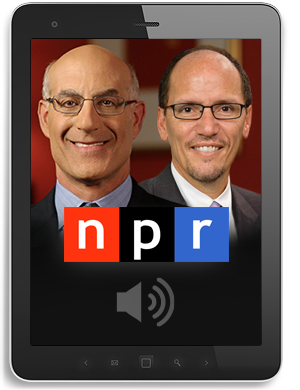Are Fees Sucking Cash from Your Retirement Account?

Rebalance Managing Director Scott Puritz details to Irina Ivanova of CBS Moneywatch the tricky practice that hides how much you pay in fees for your 401(k) account.
The typical advice for retirement savers goes something like this: Put money aside religiously, invest in many different things and make sure you’re not paying too much in fees.
But how much is “too much”?
The answer isn’t so easy to come by. More than half of American workers don’t even realize they’re paying fees on their retirement accounts, according to the National Association of Retirement Plan Participants. But this group collectively paid $35 billion in fees in 2014, according to NAARP.
Fees differ by fractions of a percent, so paying slightly more than average might not seem like a big deal. But just as retirement savings compound over time, higher-than-necessary fees can also add up, eating away a big chunk of your savings.
Here’s a simple example. Let’s assume Maya, an office manager, puts $4,000 into a retirement account every year and pays 1 percent to maintain it. Assuming an annual return of 8 percent and ignoring any employer contributions, after 35 years her account will have grown to $584,000. If she paid a fee that’s half a percentage point higher, the account balance would be $522,000.
That increase of a half-percentage point in fees costs Maya $62,000 in money she could have spent on retirement.
Here’s how to find out what you’re paying — and if you could be paying less.
Get your plan documents
401(k) plans have to disclose the fees they charge once a year, thanks to a Department of Labor rule. If your plan has a usable online interface, go into the “documentation” section and look for a document called a “408(b)(2) disclosure” or “summary plan disclosure.” You can also ask your plan administrator for the document.
But once you get it, it’s not always easy to decode, said Scott Puritz, Managing Director at Rebalance.
“In the typical 401(k), there are at least seven different levels of fees, of which one or two are transparent to consumers,” he said. “There are the fund-level fees, which are the ones that are disclosed. There is the plan sponsor fee, the record-keeping fee, and the marketing fee. These fees often are labeled differently in different plans.“
Puritz recommends going straight to the source, and writing to your plan administrator or human resources director to ask what fees you are paying on your account.
Compare the numbers
Once you get a plan’s documents or a written response, look carefully at all the fees listed, and add up those that apply to you to get a total percentage. Some people enlist a professional for this task.
“When someone comes to me, I start with a cost analysis on a portfolio and show them what they’re paying. For most people, that’s the first time they’ve ever seen that,” Kyle Moore, founder of Quarry Hill Advisors, told CBS MoneyWatch. “I hardly ever see anyone paying less than 1 percent.”
“I use a stoplight analogy with my clients,” said Brian Hanks, a certified financial planner in Salt Lake City. “If their all-in fees, including both the fund and any advisers, is over 2 percent — stop! You’re in the red and need to make changes immediately. Anything between 1 percent and 2 percent is in the yellow and could benefit from some changes. Fees less than 1 percent are green and probably OK.”
Nationally, the average 401(k) charges 0.97 percent to maintain, according to the Investment Company Institute, a trade group representing investment funds. But that’s just for carrying a 401(k) account itself. Within the account, each investment you choose will have its own fee. That’s sometimes called a “fund fee” or “expense ratio,” and it’s usually expressed as a percentage.
How much is too much? When it comes to mutual funds, actively managed funds usually cost more. They also tend to perform worse than passively managed index funds, which are tied to a set basket of investments or a market index, such as the S&P 500.
“Good index-based funds are available within this category with an expense ratio of less than 0.2 percent,” said Derek Tharp, founder of the wealth management firm Conscious Capital.
Shop around
If your 401(k) plan has fees on the high side, you’re more or less stuck as long as you’re with that employer. You can, however, change the funds you’ve invested in to reduce your overall costs somewhat.
But if you have an old 401(k) from a former employer, you’re not obligated to keep it in that employer’s plan. If you find you can get lower fees elsewhere, consider moving your money.
Sometimes, that lower-cost account will be an Individual Retirement Account, or IRA. But that’s not always the case, and some IRAs have even higher fees than 401(k)s. Moreover, since they’re governed by a different set of laws, IRAs have relatively fewer investment protections, according to the Center for Retirement Research at Boston College.
So the key is to compare individual plans carefully with each other. If you need help, enlist a financial adviser who abides by the fiduciary standard.
Consolidating several old retirement accounts into one makes them easier to keep track of — and to notice if your fees change.
“It’s so important for not only financial success, but for a sense of control, if you have your money in one or two spots versus five or six,” said Puritz.
Still not convinced? Consider this. Some years ago, research firm Morningstar compared investment funds using a number of factors, including the funds’ Morningstar star ratings and how expensive they were. While star ratings were good predictors, the firm found, they weren’t the best way to forecast investment return. Cost was.
“In every single time period and data point tested,” Morningstar said, “low-cost funds beat high-cost funds.”






